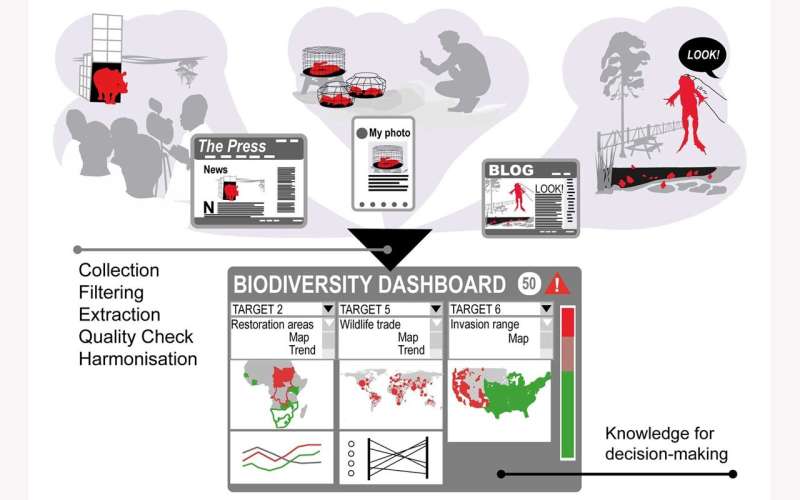This article has been reviewed according to Science X's editorial process and policies. Editors have highlighted the following attributes while ensuring the content's credibility:
fact-checked
peer-reviewed publication
trusted source
proofread
A strategy for integrating online digital data for monitoring biodiversity

Scientists from the University of Helsinki together with colleagues from other universities and institutions around the world propose a strategy for integrating online digital data from media platforms to complement monitoring efforts to help address the global biodiversity crisis in light of the Kunming-Montreal Global Biodiversity Framework.
"I think it's quite amazing that images and comments that people post online can be used to infer changes on biodiversity," says Dr. Andrea Soriano-Redondo, the lead author of a new article published in the journal PLOS Biology and a researcher at the Helsinki Lab of Interdisciplinary Conservation Science at the University of Helsinki.
"Online digital data, such as social media data, can be used to strengthen existing assessments of the status and trends of biodiversity, the pressures upon it, and the conservation solutions being implemented, as well as to generate novel insights about human–nature interactions.
"The most common sources of online biodiversity data include web pages, news media, social media, image- and video-sharing platforms, and digital books and encyclopedias. These data, for example geolocated distribution data, can be filtered and processed by researchers to target specific research questions and are increasingly being used to explore ecological processes and to investigate the distribution, spatiotemporal trends, phenology, ecological interactions, or behavior of species or assemblages and their drivers of change."
Data generated through the framework in near real-time could be continuously integrated with other independently collected biodiversity datasets and used for real-time applications.
"Data relevant to assessment of species extinction or ecosystem collapse risk, for example, could be mobilized into the workflows for generating the IUCN Red List of Threatened Species and Red List of Ecosystems," says Dr. Thomas Brooks, chief scientist of the International Union for the Conservation of Nature and a co-author in the article.
"Other data on sites of global significance for the persistence of biodiversity could be served to the appropriate national coordination groups to strengthen their efforts in identifying Key Biodiversity Areas."
Data on the illegal wildlife trade could also be integrated with the Convention on International Trade in Endangered Species of Wild Fauna and Flora (CITES) Trade Database or the Trade Records Analysis of Flora and Fauna in Commerce (TRAFFIC) open-source wildlife seizure and incident data.
Online digital data can also be used to explore human-nature interactions from multiple perspectives.
"We have successfully used social media data to identify instances of illegal wildlife trade. There is great potential to use these data to provide novel insights into human–nature interactions and how they shape, both positively and negatively, biodiversity conservation," says Professor Enrico Di Minin, senior co-author in the article, from the University of Helsinki.
"The necessary technology to implement the work is available, but it will require harnessing expertise from multiple sectors and academic disciplines, as well as the collaboration of digital media companies. Most importantly we need to ensure full access to the data as to maximize its full potential to help address the global biodiversity crisis and other sustainability challenges."
More information: Andrea Soriano-Redondo et al, Harnessing online digital data in biodiversity monitoring, PLOS Biology (2024). DOI: 10.1371/journal.pbio.3002497
Journal information: PLoS Biology
Provided by University of Helsinki




















